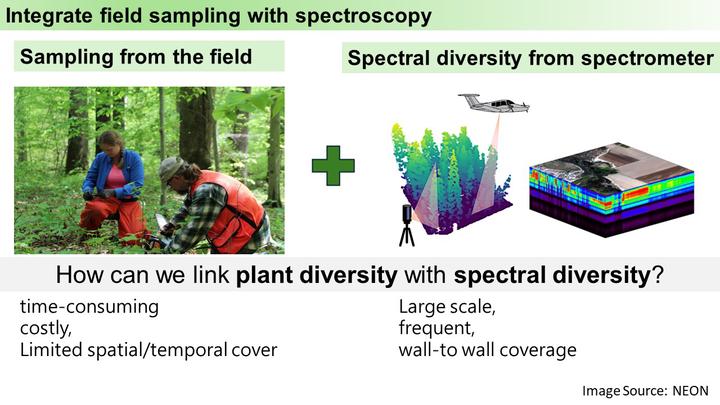
Yu Wei’s abstract: Biodiversity provides many ecosystem services and functions that human well-being is reliant on. Under climate change and disturbances caused by human activities, the loss of global biodiversity has become a growing concern. The integration of remote sensing technology with ecological sampling, particularly linking spectral diversity derived from hyperspectral imagery to ground biodiversity, has emerged as a technical frontier in assessing terrestrial plant diversity. Phylogenetic diversity, a measure of variations in phylogenetic aspects of a plant community, is directly related to the ecosystem functions provided by plants. However, the dynamics of phylogenetic diversity at large scales remain poorly understood. To fill these knowledge gaps, we aim to understand the following questions: (1) Which dimensions of plant biodiversity (e.g. taxonomic, phylogenetic) can be more effectively assessed by Spectral Diversity-Biodiversity (SDB) relationship? (2) Which environmental factors influence the strength of SDB relationships across broad biogeographic regions? To answer these questions, we synthesized ground sampling data from 10,172 individual crown measurements and 74,093 plant percentage cover records within the National Ecological Observatory Network (NEON), to estimate plant biodiversity across 38 NEON sites. Hyperspectral imageries are derived from the NEON Airborne Observation Platform (AOP), with soil pixels removed by adaptive thresholding NDVI masks. We compared 11 terrestrial biodiversity indices, including taxonomic diversity indices (species richness, Shannon’s H, Simpson index, etc.), phylogenetic diversity indices (Faith’s Phylogenetic Diversity, Mean Pairwise Distance (MPD), Phylogenetic Species Variability (PSV), Phylogenetic Species Evenness (PSE), etc.). For spectral diversity, we calculated Rao’s Q, an index that considers both spectral distance and relative abundance and compared it with the Coefficient of Variation (CV). Spectral diversity more accurately reflected dynamics in phylogenetic diversity in the majority of NEON sites. Specifically, Spectral diversity (Rao’s Q) better captured the variations in phylogenetic diversity (Faith’s Phylogenetic Diversity) than taxonomic diversity (Shannon’s H) in 26 out of the 38 NEON sites. Rao’s Q performed better than CV in 24 out of the 38 sites when predicting phylogenetic diversity, and also outperformed CV in 23 out of the 38 sites when estimating taxonomic diversity. We found strong and positive SDB relationships in most woodland/shrubland sites and weaker or negative relationships in most temperate seasonal forest sites, suggesting that spectral diversity should be used with caution when monitoring temperate seasonal forests. These findings will provide valuable insights into monitoring different dimensions of plant biodiversity across biomes.